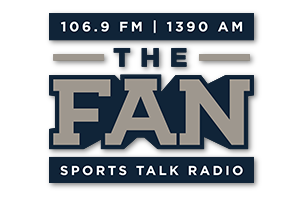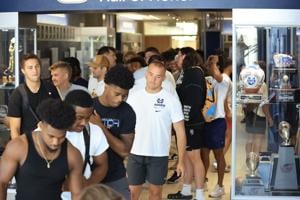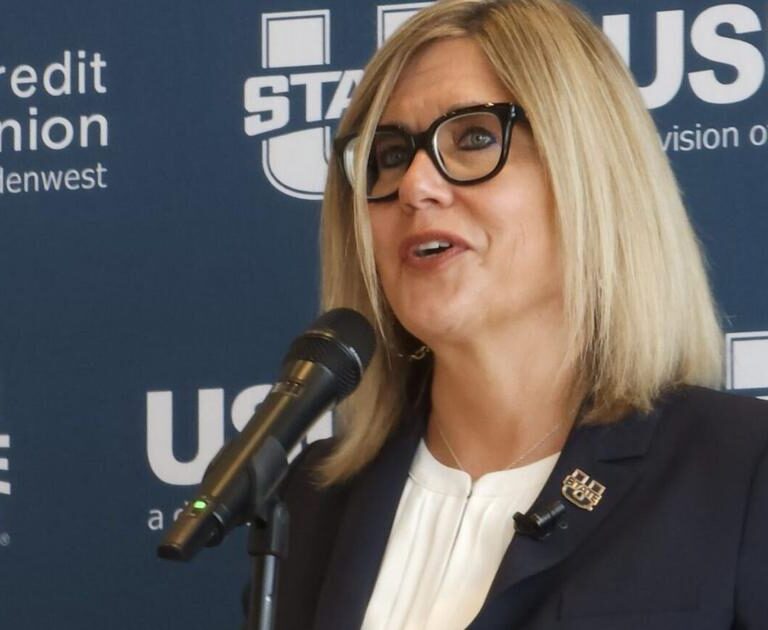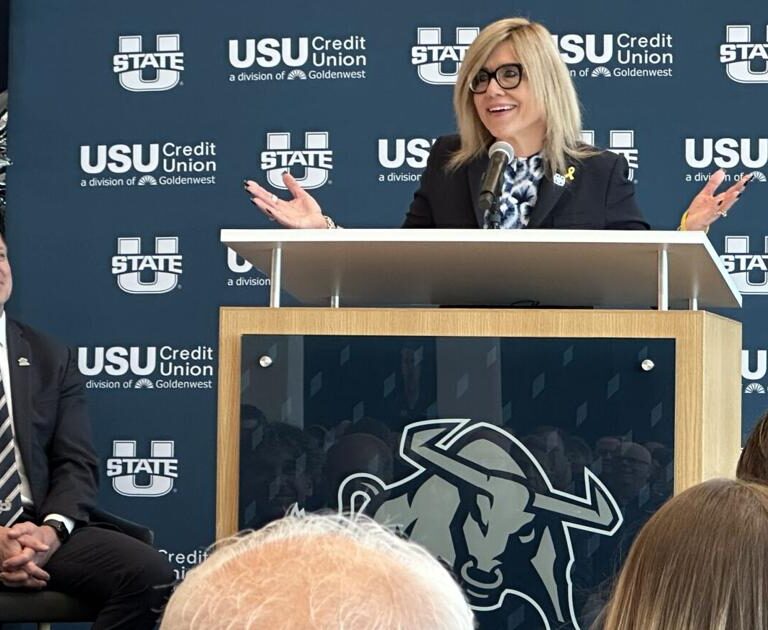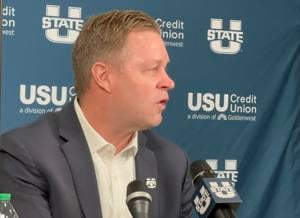
LOGAN – Bronco Mendenhall’s first signing class at Utah State is in, at least the bulk of it, as the football program introduced a total of 36 players on national signing day. Mendenhall also spoke with the media for roughly a half hour discussing these recruits and several other key topics around roster construction and the nature of recruiting and retention in modern college football.
Of the three dozen announced incoming players — not including those announced in the early signing period — there are 12 athletes from high schools, seven from junior colleges and 17 transfers from four-year institutions. Here are all of the incoming players announced today, organized by which of those three sectors they are coming from.
High School Commits
| Name | Pos. | HT | WT | Hometown (High School) |
|---|---|---|---|---|
| Malakai Alofipo | WR | 6-2 | 180 | St. George, UT (Crimson Cliffs) |
| Abe Jager | CB | 6-2 | 170 | Lehi, UT (Lehi) |
| Chris Joe | ILB | 6-3 | 205 | Brentwood, CA (Liberty) |
| Tydon Jones | ILB | 6-3 | 205 | Garland, UT (Bear River) |
| Kaleb Mitchell | WR | 6-6 | 185 | Dallas, TX (First Baptist Academy) |
| Ty Olsen | WR | 6-2 | 190 | San Diego, CA (Lincoln) |
| Cooper Rodarte | ILB | 6-2 | 225 | Enumclaw, WA (Enumclaw) |
| Joaxton Scoffield | ILB | 6-4 | 210 | Roy, UT (Roy) |
| Jared Smith | OL | 6-4 | 260 | Alpine, UT (Lone Peak) |
| Ryan-Jalen Tillman | S | 5-11 | 190 | Bountiful, UT (Viewmont) |
| Nehemiah Washington | RB | 6-0 | 205 | Federal Way, WA (Decatur) |
| Gage Yardley | ATH | 6-2 | 200 | Richfield, UT (Richfield) |
Junior College Transfers
| Name | Pos. | HT | WT | Class | Previous School |
|---|---|---|---|---|---|
| Sampson Alofipo | OLB | 6-1 | 190 | Jr. | New Mexico Military Institute |
| Kone Aumua-Uiagalelei | DL | 6-2 | 280 | Jr. | San Antonio College |
| Kamuta Levassa | OL | 6-2 | 315 | Jr. | Cerritos College |
| Tyree Morris | DL | 6-6 | 275 | Jr. | Lafayette College |
| Joshua Papu | DL | 6-3 | 300 | R-Fr. | Snow College |
| Titan Saxton | S | 5-11 | 195 | So. | Snow College |
| John Shepard | CB | 6-3 | 200 | Jr. | San Diego Mesa College |
Division I / Four-Year Transfers
| Name | Pos. | HT | WT | Class | Previous School |
|---|---|---|---|---|---|
| Bobby Arnold III | S | 5-9 | 180 | Jr. | New Mexico |
| Noah Avinger | S | 6-0 | 185 | Sr. | New Mexico |
| Brady Boyd | WR | 6-1 | 195 | Sr. | Texas Tech |
| Carter Brown | K | 6-0 | 200 | Jr. | Cincinnati |
| Miles Davis | RB | 6-0 | 215 | Sr. | BYU |
| Jake Eichorn | OL | 6-5 | 300 | Sr. | BYU |
| Anthony Garcia | QB | 6-2 | 195 | So. | Arizona |
| Brevin Hamblin | OLB | 6-5 | 205 | Jr. | Utah Tech |
| Antoineo Harris Jr. | DL | 6-3 | 255 | Sr. | New Mexico |
| Hyrum Hatch | LS | 6-0 | 210 | So. | New Mexico |
| Javen Jacobs | RB | 5-10 | 190 | Jr. | New Mexico |
| D’Angelo Mayes | CB | 6-2 | 170 | So. | New Mexico |
| Craig McDonald | OLB | 6-2 | 210 | Sr. | Minnesota |
| Braden Pegan | WR | 6-4 | 200 | Jr. | UCLA |
| Demick Starling | WR | 6-0 | 195 | Sr. | Western Kentucky |
| Bryson Taylor | CB | 6-0 | 175 | Sr. | New Mexico |
| Corey Thompson Jr. | WR | 6-0 | 180 | Jr. | UNLV |
The Aggies were flush with needs at nearly every position, given how much they lost, both from players running out of eligibility and from those who entered the transfer portal. Roughly 85 percent of snaps played by USU’s offensive players were among those now gone, with the defense seeing just over 62 percent of snaps played depart. Mendenhall said he the first four days of his tenure were spent “doing nothing other than our staff, morning to night, evaluating the current Utah State roster.” That grind took up so much of their time that the staff still has yet to fully settle, including the most basic of tasks like finding a place to live in.
“Holly and I, and my family, we’re in an Airbnb, currently, above a garage here in Logan,” Mendenhall said. I gave (the assistant coaches) the weekend off, so they’re already out of the building and some are transitioning to Logan now. Others won’t be here till after this upcoming semester with their kids in in school. So we’re all over the map currently.”
The result of the four-day, dawn-to-dusk evaluation enabled a clearer idea on what the roster needed, and at least one thing was clear: the defense needed a bit more work than the offense. Sure, the offense did lose more raw production in both snaps and stats, but the defense had essentially nothing left in the cupboard. USU’s offense lost every single starter, but retained most of the backups at nearly every position, including up-and-comers on the offensive line, at wide receiver and even at quarterback with Bryson Barnes. The defense lost basically every starter save Ike Larsen and Gabriel Iniguez plus the backups at nearly every single one of those positions.
Mendenhall went back to his New Mexico well for quite a few of his incoming defensive talent. He’s bringing with him seven players overall from his 2024 Lobos roster and five of them — Bobby Arnold III, Noah Avinger, Antoineo Harris Jr., De’Angelo Mayes and Bryson Taylor — play defense.
It’s a very typical sight to see head coaches that change jobs get players from their previous stop to make the exact same move. The reasoning behind it is pretty obvious. Those players are known quantities to the coaches, a much safer bet than trying to figure out a player based entirely on limited, or sometimes zero, film. It’s valuable to Mendenhall to have players he’s seen, though he did preface the following by saying he didn’t wan to play favorites with any play.
“I’ve seen them every single day and they’ve seen me every single day and they wanted to come. That mitigates risk for everyone,” Mendenhall said. So they have a chance to be fulfilled and have a great experience with someone they trust and vice versa.”
Also in the New Mexico pipeline, but with ties to northern Utah, are a couple of incoming defensive players, namely Titan Saxton and Tydon Jones. Saxton played at Sky View High School, starring alongside his cousin, Ike Larsen, before walking on at Utah State in 2023. He left a year later, though, to play at Snow College where his talent stood out enough to catch the eye of New Mexico staff, who recruited him to go to Albuquerque. Jones recently concluded his football career at Bear River High School and had also committed to play at New Mexico. But with Mendenhall’s move to USU, the two local stars also made that move.
Mendenhall praised the toughness and aggressiveness of both players, and particularly with Saxton he said the safety is “experienced, and we needed that at safety.” Getting two local players is also something Mendenhall said noted as part of his ideal in recruiting for the Aggies.
“If every good player in this valley stays at Utah State, to me, that’s the epitome of what Utah State is,” Mendenhall said. “And then we expand that simple circle, that starts in Cache Valley, throughout the entire state — and again that could be up to 17 players maybe more out of this state per year [with] the quality of high school football in the state, the number of players that are qualified. (Recruiting in Utah) doesn’t mean we’re compromising quality. We’re getting great players that fit and align with with our program.”
One particular thing Mendenhall was pleased with about his incoming recruits is the length of the players. Of the 36 recruits, 19 stand at least 6-foot-2, with many of those athletes playing positions where the Aggies have often lacked top-end length, such as in the defensive backfield. Some of the tallest incoming players include the 6-foot-5 Utah Tech safety Brevin Hamblin, who is moving down to play outside linebacker, along with 6-foot-6 freshman wide receiver Kaleb Mitchell, and the likewise 6-foot-6 Lafayette College defensive lineman Tyree Morris.
How tall a player is doesn’t always come up with college scouting (that tends to get a much bigger emphasis when transitioning to the NFL), but there’s obviously an impact height and wingspan have on a player’s ceiling and overall impact on the game. And Mendenhall values it a lot in his players.
“Good players, when unblocked make a plays. The great ones can beat blocks and make plays,” Mendenhall said. “The longer and the further away an opponent is away from you, you can keep them away from you. The more chance you have to get off the block and make a tackle. Same thing offensively. The more length and size, the more you can reach away from a defender. The more you can keep a tackler away from you with a stiff arm. Same thing with the offensive front. So length and size are foundational to the kind of the way that I like to bring in players.”
The balance of the three legs of recruiting — high school, junior college and Division I/II — is similar in some ways to the way former head coach Blake Anderson had begun to approach recruiting in his last couple years with USU. There is a greater emphasis on junior college and especially D1 transfers, with just 12 incoming freshman compared to 24 of the JUCO/D1 variety. But according to Mendenhall, this isn’t the ideal balance. He’d much prefer a more high school-centric recruiting class, with the transfer portal being used mostly when “we have an immediate need that has to be addressed for the next season.”
With the second major recruiting landmark reached (the first being early signing day in December), the Aggies will have to move to the next step: more evaluation. Most of these players (22 to be exact) will be with the team throughout spring ball. Mendenhall said they still have “a handful of needs” across the roster, though when asked what areas still need attention, he clarified that it had to do with depth more so than any specific position group not having received enough attention through recruiting.
“I think we’ve addressed all the areas that were needs. The question remains, are we deep enough?” Mendenhall said. “The remaining spots are not areas we haven’t addressed. And quite frankly, I won’t be able to tell you for sure until we actually play — and I’m talking spring practice — how well we truly addressed our needs. But every position that we needed was addressed in a comprehensive way. Are we deep enough? That really is the question.”
That question of depth will touch virtually every position group. A host of players were brought in at the defensive secondary, at wide receiver, running back and the front seven of the defense. Will that be enough to plug the holes lost earlier in the offseason? What about the offensive line which lost all five starters? The quarterback room is another big question mark as Barnes showed flashes of being a good QB, but will face competition from Anthony Garcia, who has familiarity with offensive coordinator and QB coach Kevin McGiven.
Mendenhall has a lot to do ahead of him, with this simply being the first major step in his rebuilding efforts with the Aggies.
